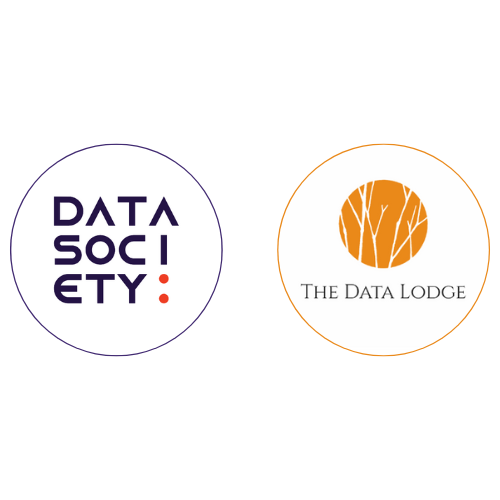AI is everywhere, or at least, that’s how it feels. From keynote stages to LinkedIn feeds, leaders are trying to make sense of the speed of change. But what does literacy actually look like in practice? And how do organizations avoid treating AI as hype while missing the deeper cultural shifts it requires?
We sat down with Dre Feeney, Director of Global Client Solutions at The Data Lodge, to get her perspective. Dre brings a business-minded lens to literacy, grounded in years of working with leaders on adoption challenges. For her, the conversation is less about technology and more about people: how they think, how they trust, and how they connect across silos.
AI Isn’t New, But Access Has Changed the Game
If you scroll LinkedIn, it can feel like AI just showed up. Dre is quick to push back on that narrative.
“AI is not new. What has changed over the past couple of years with ChatGPT is that it’s given everyday folks, people like you and me, access to just ask questions and interact with generative AI in a webpage. That visibility makes it feel like AI exploded, but organizations have been using it for decades.”
That change in access matters. When employees perceive AI as “brand new,” leaders often respond by establishing separate literacy tracks: one for data, one for AI. Dre warns that this is a mistake.
“I want to caution people that they should not separate AI literacy from data literacy. Data and AI literacy should be under the same bucket. AI is just a subset of analytical terms we teach in our framework, Information as a Second Language® (ISL).”
This perspective reframes the conversation. Instead of building competing initiatives, leaders should see AI as an extension of the broader literacy journey, one that ties directly back to culture and value.
Where Organizations Get Stuck

When we asked Dre where organizations tend to get stuck, she didn’t miss a beat: “Shiny object syndrome.”
It’s easy to believe the next platform or dashboard will unlock literacy for your organization. But buying tools doesn’t build understanding. True literacy starts with people and the language they share and the culture they create around data and AI.
Dre has seen this play out across industries, and she’s clear about why it fails.
“Oftentimes, folks are coming to literacy from the perspective of tools and technology. What tools can we implement to make it easier for people to pull insights? But really, it does not start with tools and technology. It starts with your people and your culture.”
This is a perspective Dre brings from her client-facing work. She knows that tools can create short-term excitement, but without culture, adoption fizzles. Leaders who want literacy to stick have to ground it in identity.
“How do you get everybody, from executives all the way down to frontline employees, on both the business and technical side, to realize that they are all data people? As humans, we interact with data every single day, so at The Data Lodge, we start with making it personal. Once people see the variety of ways they interact with data in their personal lives, it becomes much easier to spread literacy throughout their work lives.”
In other words, the first step isn’t rollout. It’s recognition. When employees view themselves as data-informed individuals, they stop treating literacy as an “extra” and start seeing it as an integral part of their role.
MUST READ: Scaling AI with Governance: Practical Advice from Lockheed Martin’s Mike Baylor
Literacy Beyond “Check-the-Box” Training
Even when organizations move beyond tools, they often fall into another trap: reducing literacy to mandatory training.
Dre has lived this herself.
“Data literacy gets thrown around a lot, and too often it gets reduced to mandatory training. And I don’t know about you, but when I’m asked to complete a mandatory training, I sometimes just click through to complete it. There’s no understanding in that…it’s not real literacy.”
She isn’t dismissing training, far from it. Training is essential, but only as part of a larger structure. At The Data Lodge, Dre frames literacy programs as three interconnected parts:
Engagement – communities of practice, communication strategies, program branding
Development – skills pathways and structured training (about 80% of the effort)
Enablement – office hours, glossaries, and open spaces to ask questions
“Training is huge, but without engagement and enablement, your people won’t apply what they’ve learned. These bookends, engagement and enablement, are what creates the transformational culture change you need.”
This balance reflects Dre’s sales and marketing background: development is the core product, but engagement and enablement are what make it sticky. Without them, employees may know the language of data, but they won’t use it.
Trust: The Make-or-Break Factor
If there’s one theme Dre comes back to again and again, it’s trust.
“Even though intuitively we all know that AI is not perfect, we desperately want it to be accurate. So when it spits back something false, people say, ‘Ugh, okay, I can’t trust this at all then.’ That hard stop makes it difficult to move AI projects out of their silos and into everyday workflows.”
This reaction is fundamentally different from how we respond to people.
“When a person makes a mistake, we say, ‘That’s okay, they’ll do better next time.’ But when AI makes a mistake, we tend to write off the whole system. Trust in AI isn’t just about the model, it’s about whether we trust our data, whether we trust the people using the AI, and whether we trust ourselves to make sense of the output.”
That’s why Dre frames trust as multi-layered. It’s not just about believing in the algorithm. It’s about believing in the inputs, the processes, and the people interpreting the results. Without that, adoption hits a wall.
For leaders, this means that technical accuracy isn’t enough. Building trust requires empathy, communication, and cultural alignment. These are skills that extend far beyond IT.
Looking Three to Five Years Ahead
Predicting the future of AI is a fool’s errand. Tools evolve too quickly. But when asked about the next three to five years, Dre pointed to something more enduring.
“Honestly, I don’t know what the tools will look like. But I do know this: data and AI literacy are going to become mandatory for everybody in every organization. It’s not just a corporate skill, it’s a life skill. Everyone will need the mindset, language, and skills to think critically and use these tools responsibly.”
This shift reframes literacy from a corporate initiative to a human one. Just as digital literacy became non-negotiable in the past two decades, data and AI literacy will become foundational for the next.
Organizations that invest now, helping employees build shared language, critical thinking, and trust, will be positioned to thrive. Those who wait risk being left behind.
Final Thoughts
As our conversation wrapped up, Dre came back to the core principle she shares with clients: literacy is about people first. Tools matter, but they’re not the starting point. Training matters, but it’s not the whole picture. Trust matters, but it has to be built across data, AI, and people.
At Data Society, we see the same pattern. The organizations that succeed aren’t the ones with the flashiest dashboards or the most significant technology budgets. They’re the ones that invest in their people, create cultures of trust, and build literacy as a shared foundation.
Or as Dre put it:
“Organizations that invest in their people now, their skills, their shared language, their ability to see themselves as data people, those are the ones that will be ready for whatever comes next.”
About Dre Feeney
Dre Feeney (dfeeney@thedatalodge.com) is a champion for Data & AI Literacy, helping organizations build scalable, sustainable programs that drive AI readiness, cultural transformation, and business impact. As Global Client Solutions Director at The Data Lodge, she works with executives, data & AI literacy program leads, and L&D leaders to integrate Data & AI Literacy into enterprise strategy, ensuring teams have the mindset, language, and skills to navigate the evolving digital landscape.
Before joining The Data Lodge, Dre led a data team at Collins Aerospace, where she saw firsthand how gaps in data literacy hinder AI adoption, decision-making, and innovation. Her passion for data began while earning her pilot’s license, analyzing flight patterns to improve performance, a mindset she now applies to helping organizations turn data into a strategic asset.
Dre is dedicated to future-proofing workforces, bridging the data literacy gap, and empowering organizations to build confident, data-informed cultures.
Learn more about The Data Lodge here: https://www.thedatalodge.com/
FAQ: Building Trust and Literacy with Dre Feeney from The Data Lodge
AI is a subset of analytics and data literacy. Splitting them into separate tracks creates silos and confusion. Dre Feeney emphasizes that “AI is just a subset of analytical terms we teach in our Information as a Second Language® (ISL) framework.” Integrating both under one literacy strategy ensures consistency, shared language, and cultural alignment.

